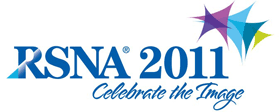
Abstract Archives of the RSNA, 2011
Shaun Patel MD, Presenter: Nothing to Disclose
James S. Babb PhD, Abstract Co-Author: Nothing to Disclose
Emilio Vega, Abstract Co-Author: Nothing to Disclose
Michael Macari MD, Abstract Co-Author: Nothing to Disclose
There is controversy regarding the optimal CT technique for the investigation of suspected appendicitis. We sought to determine appendiceal visualization rates at CT in the same patient with and without oral and IV contrast.
33 consecutive subjects underwent dual energy MDCT (Flash, Siemens) and received oral and IV contrast material. Data were acquired at 80 and 140 kVp. Patients received 1000 ml of positive oral contrast ingested over 60 minutes and 1.5 ml/kg of IV contrast prior to imaging. Data were sent to a workstation equipped with software allowing the generation of virtual non-contrast (VNC) data. Data were initially evaluated using VNC images only by two radiologists independently (Reader 1, third year resident; Reader 2, abdominal radiologist with 15 years experience). Appendiceal visualization was graded on a 4 point scale, 1 definitely not visualized, 2 probably not visualized, 3 probably visualized, 4 definitely visualized. The data were then reevaluated using the same scale but with both oral and IV contrast (CECT) present. A paired-sample Wilcoxon test was used to compare the VNC and CECT with respect to the visualization scores from each reader. Logistic regression for correlated data was used to derive a 95% confidence interval for the percentage of cases in which VNC data will show a lower visualization score than the CECT.
The mean ± standard deviation of the visualization scores averaged over the readers was 3.03 ± 1.17 for the VNC data and 3.05 ± 1.17 for the CECT data, (p=0.834). 0/29 cases evaluated by the experienced reader and 4/29 cases evaluated by the resident showed a lower visualization score using the VNC images when compared to CECT. The percentage cases that can be expected to show lower visualization or decreased confidence on VNC images is estimated to be 7.0% with a 95% confidence interval from 2.4% to 17.0%. The data provide 95% confidence that for an inexperienced reader, up to 17% of patients will demonstrate lower appendiceal CT visualization scores without contrast then when compared with a CECT examination.
Our data suggest that for inexperienced readers, oral and IV contrast improves appendiceal visualization rates when compared with non-contrast CT exams.
If residents are interpreting CT examinations for appendicitis, the use of oral and IV contrast may improve confidence in appendiceal visualization.
Patel, S,
Babb, J,
Vega, E,
Macari, M,
Effect of Oral and IV Contrast on Appendiceal Visualization Rates in the Same Patient Using MDCT. Radiological Society of North America 2011 Scientific Assembly and Annual Meeting, November 26 - December 2, 2011 ,Chicago IL.
http://archive.rsna.org/2011/11003094.html

